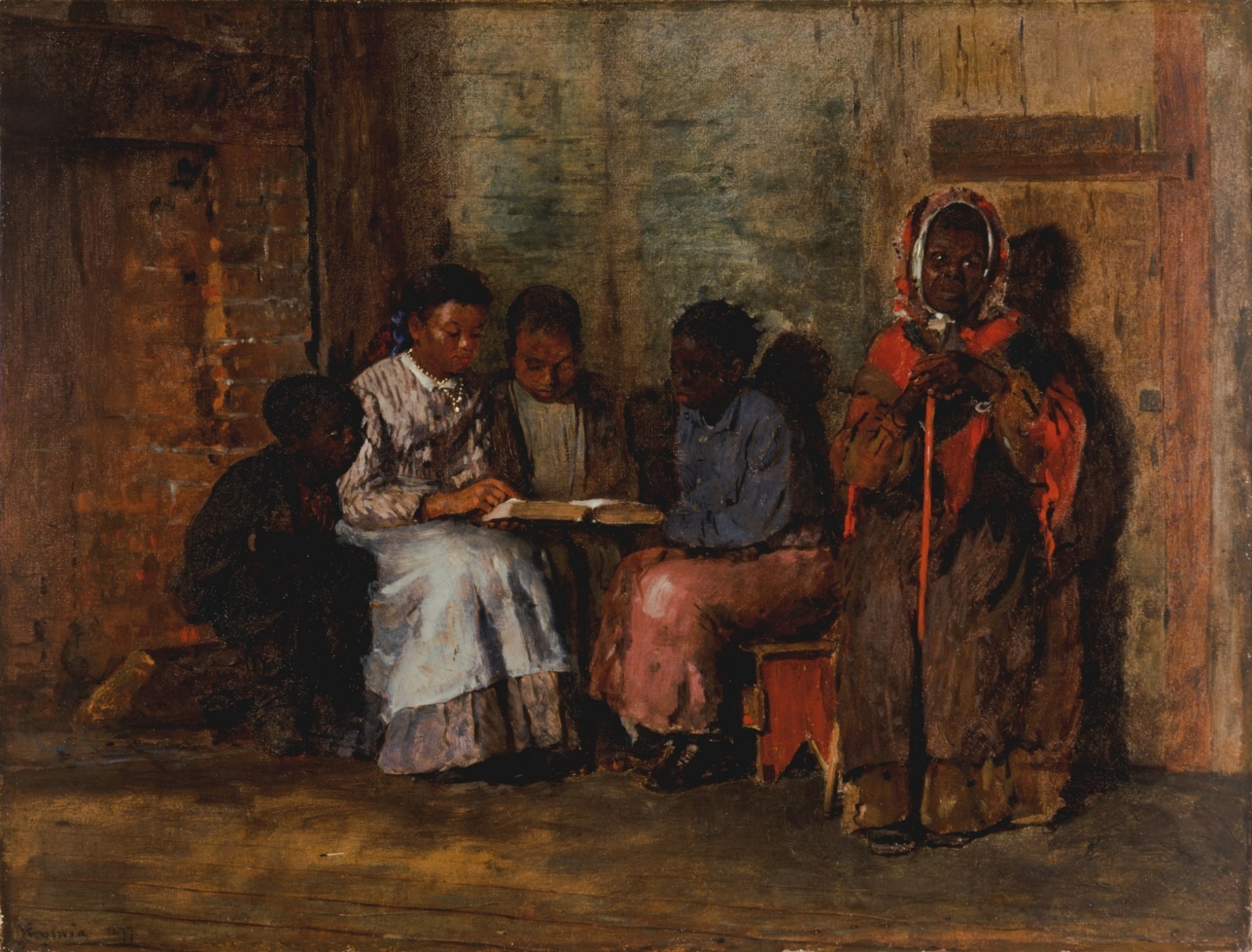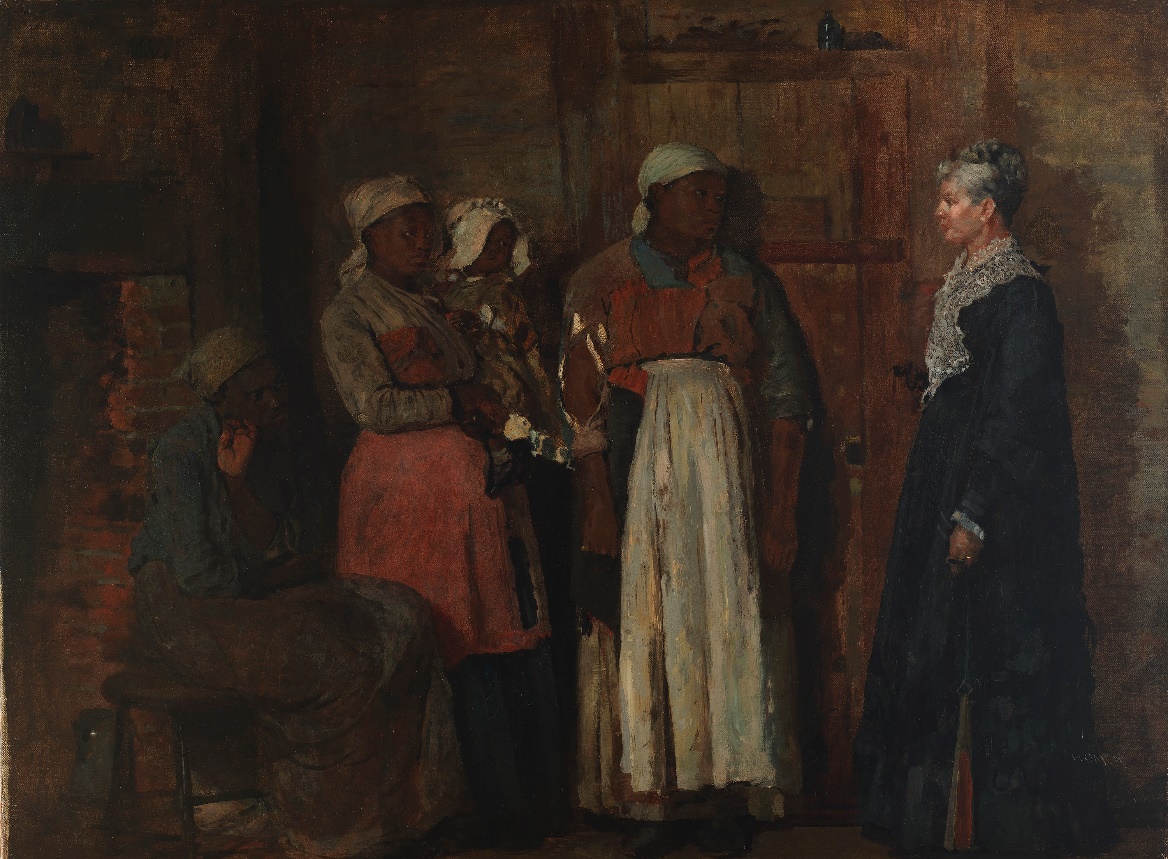Homer, Winslow - VM - William R. Cross
Winslow Homer: Sunday Morning in Virginia

Truth through Tension
by William R. Cross
Winslow Homer commemorated his nation’s 100th birthday in several ways – one of which was making this picture.
A dozen years after the Emancipation Proclamation (1863) that liberated American slaves, a new life is opening at the center of a cabin built for their meager shelter. Light flickers on the worn bricks of the hearth, as an unseen fire casts shadows on the wall behind four children. The eldest of them, a well-dressed teenaged girl, reads aloud from her Bible as two boys and another girl, each younger than she, listen attentively and read silently themselves. On this Sunday morning in Virginia these children learn not only to read but to live more freely than their grandparents, housed in these same quarters, ever did. Yet how open is the world within which these children seek to flourish? Homer depicts a door, but it is closed, and he shows us no windows – indeed no daylight. The radiant word of Scripture offers pathways out of the room and into the world. But what stumbling blocks lie upon those rough roads?
Homer painted a second canvas, sized similarly and set in precisely the same room, with the same perspective before the same fireplace at the heart of the same wooden shack. But the figures in this second picture contrast with those in the first. Three young black women, one holding an infant, confront an unwelcome visitor: the older white woman to whom they were once enslaved. The fire is extinguished now, the Bible missing. A touch of domesticity appears atop the door’s transom: a pair of glass bottles, one gleaming and upright, the other fallen and dull. At first glance the former mistress appears genteel, well-meaning in her sober black dress adorned with white lace. She may be a Confederate widow still in mourning and wearing her wedding ring. The three women, however, and even the child, appear to question her intentions. Homer paints the interior of the fan dangling from her left hand with the same red hue of the cane and shawl of the woman in the first painting. To the eyes of some that color is of blood, which drenched the entirety of the “peculiar institution” upon which this white woman once built her wealth.

The two canvases comprise a kind of diptych: on the left, Sunday Morning in Virginia and on the right A Visit from the Old Mistress. Six times Homer sent the two pictures to exhibitions with a written preference for their placement together as “companions.” He created the pair at a moment of personal and national reflection. 1876 was both the American Centennial and an election year of ferment. The great hope for Reconstruction – a program of structural change that would effectuate true and lasting equality for all Americans regardless of race – had turned to disappointment. Homer and many others lived in sorrow at its failure.
The pivot between the two pictures is the older woman on the right in Sunday Morning. She occupies the same position in her picture as does the former mistress in A Visit. She looks not to the children or to their Bible but out of her own picture’s frame into the other picture. Her praying hands, placed firmly atop her red cane, tell her story; she has endured “a lifetime of waiting,” as one contemporary critic observed. Although she cannot read the Gospel herself, she listens, wistful and grateful that with time and practice her grandchildren will. She hears Scripture as spoken by God and lives in hope for his promised freedom, both in this world and the next.
*******
Winslow Homer: Sunday Morning in Virginia, 1877, oil on canvas, 18 3/8 x 24 in. Cincinnati Art Museum, Cincinnati, Ohio, USA.
Winslow Homer: Visit from the Old Mistress, 1876. Oil on canvas, 18 x 24 1/8 in., Smithsonian American Art Museum, Washington D.C., USA.
Winslow Homer (1836–1910) is often called America’s favorite painter. Born in Boston, Massachusetts and raised primarily in nearby Cambridge, he moved at 23 to New York. For the following 16 years he earned a living mostly by designing wood engraved illustrations which he sold to newspapers such as Harper’s Weekly. Homer began exhibiting watercolors in 1874 to critical and popular acclaim, which allowed him to live off the sales of his prolific works in oil and watercolor. He was highly observant in all respects but one: religiosity. He lived across the street from a church in which he is never documented to have worshipped. Yet the annotations in his library, his correspondence, and many attributes of his work suggest that like his devout Christian mother and father, he too walked in faith, albeit at an idiosyncratic amble. Best known for his marine scenes, Homer died in his studio at Prouts Neck, a rocky promontory on the coast of Maine, where he spent much of the last 27 years of his life. The most ambitious display of Winslow Homer’s work in more than a generation is hanging at the Metropolitan Museum of Art in New York through 31 July, 2022 (Winslow Homer: Crosscurrents). A version of the show will open at the National Gallery in London, England, on 10 September, 2022.
William R. Cross is the author of Winslow Homer: American Passage, a biography of released by Farrar, Straus & Giroux in April 2022, from which this column is adapted. He writes a weekly column on art and the Gospel for his fellow parishioners at Christ Church, Hamilton, Massachusetts, USA. His author website is WRCross.com and his Instagram page is WRCrossAuthor.
ArtWay Visual Meditation 26 June, 2022


